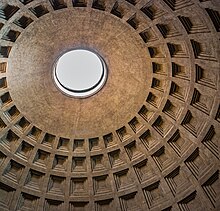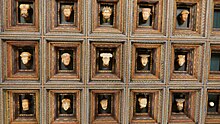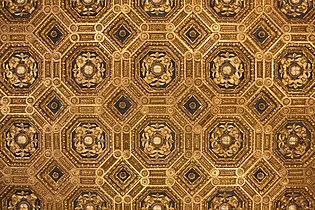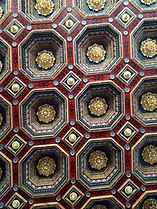Coffer


Acoffer(orcoffering) inarchitectureis a series of sunken panels in the shape of a square, rectangle, oroctagonin aceiling,soffitorvault.[1] A series of these sunken panels was often used as decoration for a ceiling or a vault, also calledcaissons( "boxes" ), orlacunaria( "spaces, openings" ),[2]so that a coffered ceiling can be called alacunarceiling: the strength of the structure is in the framework of the coffers.
History
[edit]The stone coffers of theancient Greeks[3]andRomans[4]are the earliest surviving examples, but a seventh-century BCEtruscanchamber tomb in thenecropolis of San Giuliano,which is cut in soft tufa-like stone reproduces a ceiling with beams and cross-beams lying on them, with flat panels filling thelacunae.[5]For centuries, it was thought that wooden coffers were first made by crossing the wooden beams of a ceiling in theLoire Valleychâteauxof theearly Renaissance.[6]In 2012, however, archaeologists working under the Packard Humanities Institute at the House of the Telephus inHerculaneumdiscovered that wooden coffered ceilings were constructed in Roman times.[7]Experimentation with the possible shapes in coffering, which solve problems ofmathematical tiling, or tessellation,were a feature ofIslamicas well asRenaissance architecture.The more complicated problems of diminishing the scale of the individual coffers were presented by the requirements of curved surfaces of vaults and domes.
A prominent example of Roman coffering, employed to lighten the weight of the dome, can be found in the ceiling of therotundadomein thePantheon, Rome.
Coffered ceilings were used in cathedrals starting withSt Mark's BasilicaandSanta Maria Maggiore.They spread following the reforms of theCouncil of Trent,as the improved acoustics and opportunity to include statues, apostolic heraldry[8]and other religious elements in compositions with versatile shapes was thought to enhance the doctrinal purpose of a cathedral.[9]
Asian architecture
[edit]Inancient Chinese wooden architecture,coffering is known aszaojing(Chinese:Tảo tỉnh;pinyin:zǎojǐng).[10]
Gallery
[edit]-
Coffered ceiling of the Sala dell'Udienza, in thePalazzo Vecchioin Florence
-
Chapelle Expiatoire,Paris
-
Giuliano da Sangallo's flat caisson ceiling fromBasilica di Santa Maria Maggiore,Rome
-
Coffered ceilings ofMir Castle,Belarus
-
Chancel ceiling,Church of the Good Shepherd (Rosemont, Pennsylvania)
-
Coffered ceiling, Stock Exchange Pallace,Zagreb
-
Coffered ceiling typical of stations on theWashington Metro(Washington, DC)
See also
[edit]- Dome
- Dropped ceiling
- Coveceiling
- Beamceiling
- Muqarnas
Footnotes
[edit]- ^ Ching, Francis D.K. (1995).A Visual Dictionary of Architecture.New York: John Wiley & Sons, Inc. p. 30.ISBN0-471-28451-3.
- ^An alternative, in a description ofDomitian's audience hall byStatius,noted by Ulrich 2007:156, islaquearia,not a copyist's error, as it appears inManilius'Astronomica(1.533, quoted by Ulrich).
- ^An example is the mainhieronatSamothrace,where stone ceiling beams of thepronaoscarried a coffered ceiling of marble slabs across a span of about 6.15 m (J.J. Coulton,Ancient Greek Architects at Work: Problems of Structure and Design;Cornell University Press) 1982:147;ISBN978-0801492341)
- ^Roman wooden coffered ceilings are discussed in Roger Bradley Ulrich,Roman Woodworking,ch. "Roofing and ceilings" (Yale University Press) 2007.
- ^Illustrated in Ulrich, fig 8.27.
- ^"coffer".Encyclopædia Britannica Online.Retrieved2007-10-17.
- ^Hooper, John (2012-07-23)."House of the Telephus Relief: raising the roof on Roman real estate".The Guardian.Retrieved2015-01-16.
Buried by Vesuvius nearly 2,000 years ago, archaeologists at Herculaneum have excavated and carried out the first-ever full reconstruction of the timber roof of a Roman villa
- ^Freiberg, Jack (January 2019). "The Heraldic Ceilings of the Lateran Basilica".Di Sotto in Su: Soffiti nel Rinascimento a Roma.Rome, Palombi editore. pp. 39–60.
- ^Tosini, Arianna (2022)."Coffered ceilings in the churches of Rome, from the 15th to the 20th century"(PDF).TEMA - Technologies Engineering Materials Architecture.8(1): 110.doi:10.30682/tema08SIi.
- ^Ching, Francis D.K.; et al. (2007).A Global History of Architecture.New York: John Wiley and Sons. p.787.ISBN978-0-471-26892-5.








